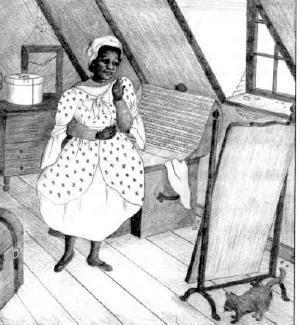|
FRESH STUFF DAILY |
|
|
||
|
|
||
|
|
||
|
SEE ALL SIGNED BOOKS by J. Dennis Robinson click here |
||
The first edition of this children’s novel sold out. A second self-published edition is now in print. To honor that occassion we asked author Pat Wall to tell us what she has learned about writing, lecturing, publishing and marketing. Also included is out original interview on the release of her book about an enslaved girl growing up in an 18th century New Hampshire seaport.
READL Slaves in the Warner House Child Out of Place: A Story for New England is Pat Wall’s first book. As a former tour guide at Strawbery Banke and at the Warner House where the story takes place, Pat came to know Portsmouth history. But there were stories still untold, she says. Then a voice began to whisper to her from the past, sending the author on a journey to places she had never imagined. Combining fact with fiction, Pat Wall created Matty, an enslaved girl living in a New Hampshire seaport at the turn of the 19th century. The resulting novel for children is illustrated by Debby Ronnquist who created some of the first imagined images of colonial African-American life in Portsmouth, NH. We asked Pat Wall about her experiences as an historian and first time author. CHILD OUT OF PLACE VISIT our Black History section WHAT I'VE LEARNED SO FAR
No, it doesn’t qualify as a best seller, but the first printing of 2,200 copies is gone and I’ve done a small reprint run. And I finally got sensible and signed up with Amazon.com. Now, if I could just find a commercial publisher to buy rights in the book, I could devote all my time to getting a sequel down on paper. It seems my character, Matty, is eager to tell more stories about her family. Though CHILD is a work of historical fiction, it apparently is achieving its goal of opening people’s eyes to a long neglected chapter in the history of enslaved Africans – the New England chapter. The most frequent response I hear from readers (especially adults and teachers) is -- "I had no idea there were slaves in New England." Since November 2003 when Portsmouth’s Seacoast African American Cultural Center kindly debuted the book, I’ve done a number of store signings, talked with various groups, taken part in a teachers’ seminar and visited with over 1700 students (3rd – 6th graders) in New Hampshire and southern Maine. At each classroom visit, before we talked about the book, I asked kids to tell me what they knew about the era of slavery. Always, they told me about the Civil War and slavery in the South. Then they talked about the "neat" stories they’d read about Harriet Tubman and the Underground Railroad. Invariably, some youngster would pipe up that he was certain his house was part of that because "there’s this funny closet in the attic" (or cellar). I can only hope that my book might serve to alter the schools’ outmoded curricula, one that still leaves children with the impression that New Englanders were the "good guys" and that slavery only happened down South. In some schools where I visited, students were already familiar with my book so discussion flowed delightfully. In other schools I had to lay a bit of groundwork and read a chapter or so, but soon discussion became just as lively. Often we ended up talking about prejudice and ways to overcome it. Such discussions and hearing student feedback about CHILD was wonderful. My day was often "made" when a youngster said he "could feel what Matty felt" or felt as if she were "with Matty in that old house in Portsmouth." Whenever I agree to visit a school, I do not go with the intent of selling books because it isn’t fair to pressure the kids. However, if any are sold, I always donate 40% of any sales to the school library or PTA fund. I have the same give-back policy for lectures to non-profit organizations and, unless I have to travel more than 40 miles from home, I don’t ask for a small expense fee.
TAKING THE BOOK TO MARKET Marketing a self-published book, getting reviewers, book dealers and such beyond this seacoast region to give it any consideration was (and still is) the toughest part of all. And I do understand why, what with the constant flow of new books seeking attention. Floodgates and gatekeepers are in place everywhere. However, I did manage to place my book in quite a few New England stores and museum shops beyond Portsmouth. Occasionally, it seemed that prejudice factored into a rejection. A few store owners said they didn’t think the people who came to their store would buy this book. One came right out and said there weren’t many black people who came to his store. But, as my Mother often said, "You got to learn to take the bad with the good." Most rebuffs haven’t bothered me that much, though there was one that still stings. It involved the children’s division of the New York Public Library. My book had been forwarded to them by an African American organization in the City. When I called NYPL to inquire if they’d received it, the person in charge told me, "Oh yes, we got it, but we just threw it out because we only consider books which come from well known publishers." And so it goes. And yes, I plan to keep on keeping on. For those who might care to read them, I’ve still got stories that need telling. ALSO: Black Portsmouth by Cunningham and Sammons CONTINUE to read our INTERVEW with author PAT WALL
INTERVIEW WITH PAT WALL SeacoastNH PAT WALL I think once readers move on into the story, carried along by more of Debby's heart warming drawings, they'll discover it's got all sorts of stuff to hold their interest. While it does reveal much about the different nature of slavery in New England -- as compared with most of the South - it's really about a child's determined optimism in the face of harsh reality. Despite what young Matty's relatives tell her, she's certain there's a special, happier place for her, a "belonging place", she calls it and that one day soon she'll get there. I realize that slavery is an uncomfortable topic for some parents and teachers of young children. This story provides a gentle way to get discussions going, help kids empathize with young Matty, be with her as she's forced to confront the reality for African Americans in 1806. It's the human connection that makes history fun. Lots of textbooks fail at that. SeacoastNH PAT WALL Of course, research was only one big stumbling block on the way to creating Child Out of Place. Though I'd been writing non-fiction journalism for years, I had to learn a whole new writing craft, learn to create characters and historically accurate settings, get characters to interact, respond to their situations and settings -- hundreds of new challenges for me. Even word for word, the language had to be accurate for the times. Thank goodness for the Oxford English Disctionary.
So many times, over that first year or so, I walked away from the whole thing, threw away chapters, even a draft of what I thought was a finished book. I never had that much trouble when writing for newspapers. All I had to do then was create a snappy first sentence hook and let the fishing line play out until the editor cut it. A novel is a whole different critter. But something -- likely my character Matty -- kept pushing me. I knew she had an important, unusual story to tell. I just wasn't sure I was the one she needed to tell it. It's a funny feeling to invent a character and then she begins to talk to you. No, I wasn't hearing voices. The more I learned about enslaved Africans in the North, the more I felt compelled to write a story about that for youngsters. It's a chapter that's missing from their textbooks. In retrospect, I'm ever so grateful Matty came along. she changed me, opened new horizons for me, intellectually and personally. She set me on a mission. SeacoastNH PAT WALL Prior to about 1760, I think the word "isolation" best describes the difference between enslaved Africans in New England compared with those in the South. As Matty's great uncle Ned tells her, "Bad as that Barbados plantation was for our parents, at least there they had the comfort of friends near by." That wasn't true in early Portsmouth. SeacoastNH PAT WALL SeacoastNH PAT WALL There are pluses to self-publishing. You've got more control over the outcome than with most commercial publishers, especially in regard to illustrations. Every time I look at the book, I thank God that Debby Ronnquist came along. It was such joy working with her. The price tag to produce 2000 books was about equal to a couple of those adventure trips seniors like to take. I certainly got far more enjoyment and satisfaction on my "book trip." I wish I could have afforded a hardcover edition. There's not much for posterity in paperbacks. But, who knows, maybe Fate will smile one day and a commercial publisher will buy it and do it up proper. As for not having an editor -- in a way -- I actually had multiple editors, especially my daughter, as well as many caring friends who read and commented on various drafts of the manuscript. They're all listed in the book. SeacoastNH PAT WALL SeacoastNH PAT WALL To my surprise, on one of my visits, I imagined a servant child and, she was black. Questions about her flooded in, and soon Matty came into being. The more I got immersed in early African American history, the more Matty and her story took shape. At first, I did worry that my being white would be a barrier. But I soon realized that ignorance is the barrier, not skin color. As for dealing that "distant time" you asked about, I grew up surrounded by the past, by antique furniture and parents who loved American history. They often dragged me off to visit historic sites and old houses. I loved it but, as kids will do, I often made fun of all that "old stuff." Somewhere, up there, my folks are now having the last laugh. Copyright © 2004 SeacoastNH.com. All rights reserved. Please visit these SeacoastNH.com ad partners.
News about Portsmouth from Fosters.com |
| Thursday, April 25, 2024 |


|
Copyright ® 1996-2020 SeacoastNH.com. All rights reserved. Privacy Statement
Site maintained by ad-cetera graphics





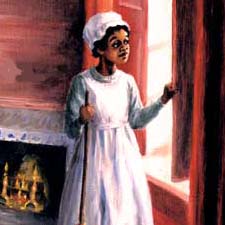 SEACOAST BOOKS
SEACOAST BOOKS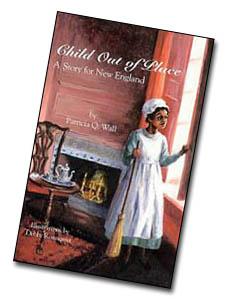 To write a book is to stick one’s neck out. To self-publish a book is to stick it way out. But, so far, I haven’t heard the whisper of an ax. On the contrary, my novel, CHILD OUT OF PLACE: A Story for New England, has been finding a warm welcome in this seacoast region and, increasingly at locations around the country.
To write a book is to stick one’s neck out. To self-publish a book is to stick it way out. But, so far, I haven’t heard the whisper of an ax. On the contrary, my novel, CHILD OUT OF PLACE: A Story for New England, has been finding a warm welcome in this seacoast region and, increasingly at locations around the country.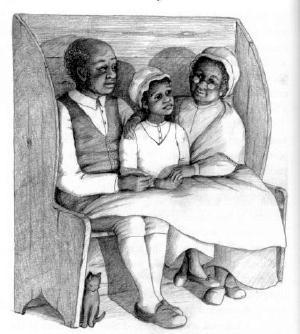
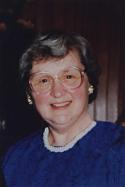 Curiosity, I hope. The title is likely to strike a familiar cord. Most kids at one time or another have had that uncomfortable feeling of being "out of place"...not belonging. And, the book's cover, painted by my friend and illustrator, Debby Ronnquist, does stir the imagination. Were I a teacher, I'd challenge my students to make up their own story just on that cover.
Curiosity, I hope. The title is likely to strike a familiar cord. Most kids at one time or another have had that uncomfortable feeling of being "out of place"...not belonging. And, the book's cover, painted by my friend and illustrator, Debby Ronnquist, does stir the imagination. Were I a teacher, I'd challenge my students to make up their own story just on that cover.